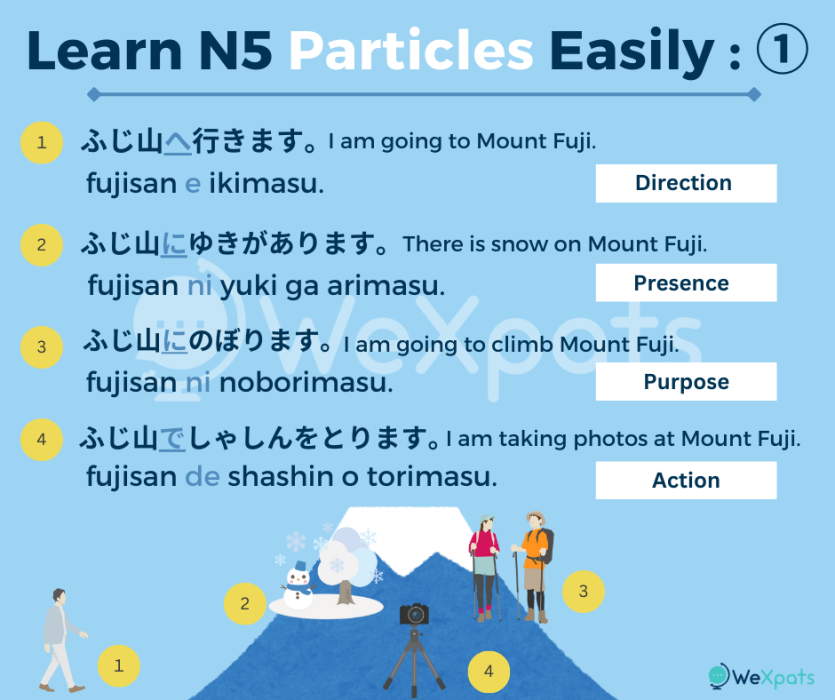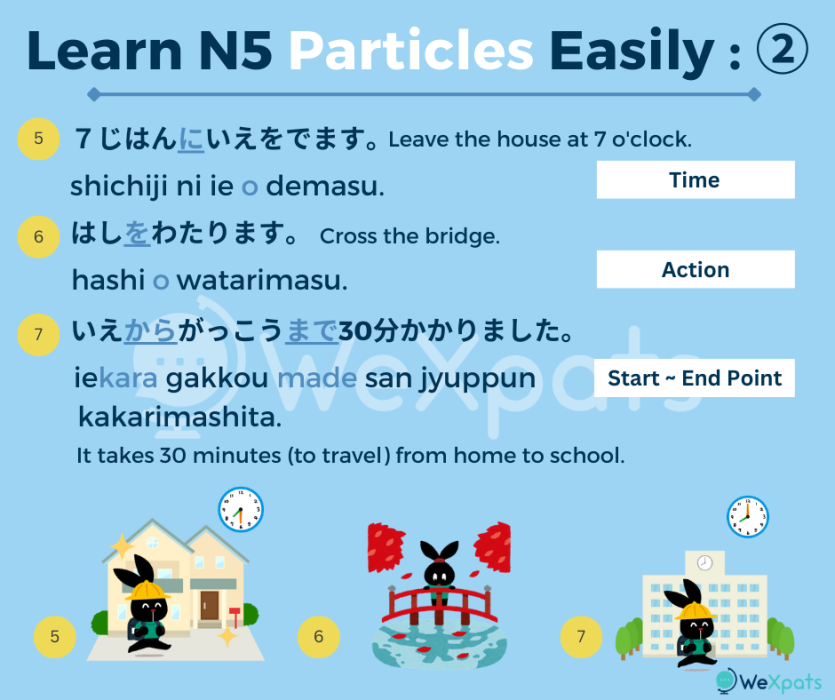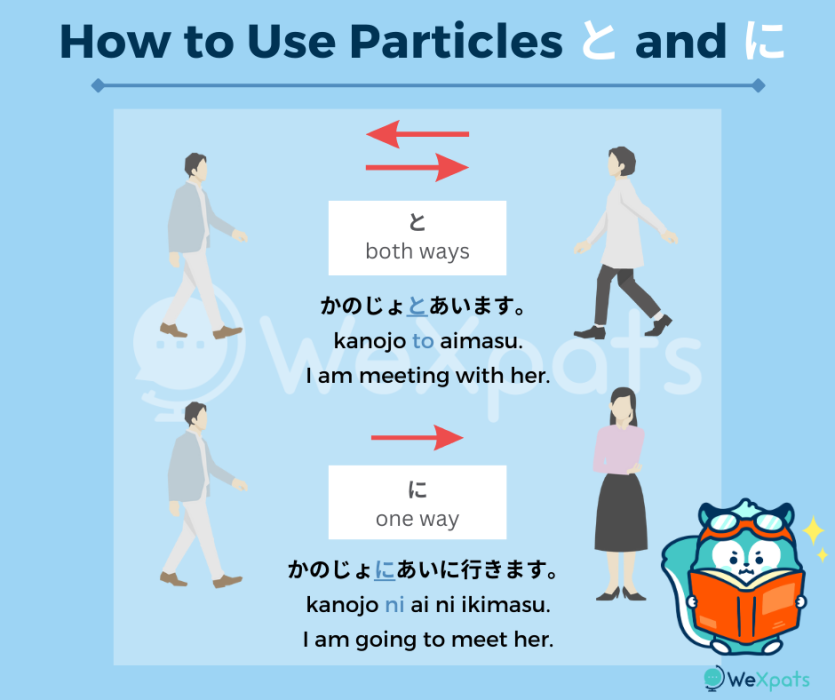Particles are essential when constructing Japanese sentences. Called 助詞 (joshi) in Japanese, particles are necessary for reading, writing, or speaking in Japanese.
For example, “わたしは〇〇です。(watashi wa 〇〇 desu) - I am 〇〇”. In this sentence, “は (wa)” is the particle that indicates わたし as the subject.
This tie, we have put together a list of the most common and basic particles you need to know in the JLPT N5 level and 3 things to be aware of about N5 particles.
Table of Contents
- Japanese Particles - 助詞
- N5 Particles List
- How to Learn N5 Particles Easily
- Things to be Aware of about N5 Particles
Japanese Particles - 助詞
助詞 (Joshi) are Japanese particles that form connections between other words. It does things like make the meaning of nouns more apparent. Therefore, it is very important to master Japanese particles at the basic level. By knowing how to use Japanese particles properly, you will be able to speak and write correctly. The meaning of a sentence can be very different depending on what particle you use.
In this article, we will list the Japanese particles that you should know and master at the basic level.
Writer's Pick
N5 Particles List
This table summarises the Japanese particles found in N5. The same particle may have different uses, so we recommend memorising example sentences along with their usages. Some particle usages may seem very similar as well, so try to not confuse them.
Note that for the following 3, their reading changes when used as particle:
-
は (ha) → wa
-
を (wo) → o
-
へ (he) → e
|
Particle |
How to Use |
Example Sentence |
|---|---|---|
|
は |
is / am |
わたしは日本人です。 |
|
は |
(comparison) |
やさいは食べますが、にくは食べません。 |
|
か |
what |
名前は何ですか? |
|
も |
also |
わたしも友だちも学生です。 |
|
を |
(object) |
ごはんをたべます。 |
|
を |
(starting point) |
いえを出ます。 |
|
を |
(cross) |
はしをわたります。 |
|
へ |
to |
学校へ行きます。 |
|
に |
to |
学校に行きます。 |
|
に |
(target) |
先生に聞きます。 |
|
に |
at |
7時に起きます。 |
|
に |
to |
はなをかいに行きます |
|
に |
on / at (presence) |
つくえの上に本があります。 |
|
で |
by / with |
電車で学校へ行きます。 |
|
で |
at / in |
しょくどうでひるごはんを食べます。 |
|
と |
and |
つくえの上に本とえんぴつがあります。 |
|
と |
and / with |
友だちとえいがを見に行きます。 |
|
や |
〇〇, 〇〇, and |
つくえの上に本やえんぴつなどがあります。 |
|
の |
of (affiliation) |
わたしはWeXpatsのしゃいんです。 |
|
の |
(possession) |
これはわたしの本です。 |
|
の |
(origin) |
これはアメリカの車です。 |
|
が |
(subject) |
だれがきましたか? |
|
が |
but, however |
日本語はむずかしいですが、おもしろいです。 |
|
から |
so, because |
今日は友だちのたんじょうびですから、早くかえります。 |
|
から~まで kara~made |
from ~ to |
7時から8時までべんきょうします。 (shichi-ji kara hachi-ji made benkyoushimasu) - I study from 7 o’clock to 8 o’clock. |
|
より yori |
than |
とうきょうはおおさかより大きいです。 (toukyou wa oosaka yori ookii desu) |
|
だけ |
only |
一時間だけべんきょうしました。 |
|
よ |
(sharing info) |
このレストランはおいしいですよ。 |
|
ね |
isn't it (agreement) |
このレストランはおいしいですね。 |
|
ね |
isn’t it / I believe |
これは山田さんのかばんですね。 |
How to Learn N5 Particles Easily


Make Sure You Know How to Use Each Particle Correctly
As you can see in the N5 Particles List above, there are many different ways to use particles. Therefore, it is more effective to remember how to use each one than to translate and memorise the particles’ meanings.
For example, with the particle の (no), it is more important to learn how to use it.
の - possessive
これはわたしのカバンです。
(kore wa watashi no kaban desu)
- This is my bag.
の - indicating part of an organisation
わたしは〇〇大学の学生です。
(watashi wa 〇〇 daigaku no gakusei desu)
- I am a student of 〇〇 University.
の - place of origin
これは日本のくるまです。
(kore wa nihon no kuruma desu)
- This is a Japanese car.
これはアメリカのけいたいです。
(kore wa amerika no keitai desu)
- This is an American cell phone.
As you can see, though all 3 are の particles, they are not all used to show possession. The most effective way is to learn how to use each particle rather than what they mean.
Take of Note of Particles that are Used with Verbs
When studying some particles, it is easier to remember them with other similar particles. For example, let’s look at で (de) and に (ni), the particles that show location. If you remember both で and に simply as particles for places, and use them indiscriminately for any situation involving places than you will confuse the two.
So how do you differentiate で and に ? The best way is to remember example sentences for each to grasp the pattern. At the N5 level, the number of verbs to learn is still little, so this is a convenient point to memorise.
For example, let’s look at how to use で and に.
-
しょくどうでご飯を食べます。
(shokudou de gohan wo tabemasu)
- I eat at the cafeteria. -
しょくどうに先生がいます。
(shokudou ni sensei ga imasu)
- Teacher is at the cafeteria.
In front of で or に are place nouns - place noun + で / に. However, what comes after is where で and に differ. After に is a verb that shows presence - いる (iru), while で is followed by an action verb - 食べる (taberu).
To make it simple to understand:
-
place noun + で + action verb : to show performance of an action at a place
-
place / target noun + に + verbs that show presence, target, purpose, direction, destination
Verbs Commonly Used with に
Below are verbs commonly used with に. Rather than a place noun, it is a target noun that is in front of に.
-
頼む / たのむ / tanomu : to request
-
教える / おしえる / oshieru : to teach; to tell
-
話す / はなす / hanasu : to talk
-
貸す / かす / kasu : to lend
-
返す / かえす / kaesu : to return; to give back
-
渡す / わたす / watasu : to pass
-
見せる / みせる / miseru : to show; to let see
-
電話をかける / でんわをかける / denwa wo kakeru : to make a call
-
会う / あう / au : to meet
-
聞く / きく / kiku : to ask
For example, “先生に聞きます。 (sensei ni kikimasu) - Ask teacher”. Teacher (noun) is the “target” to be asked (verb) as indicated with に.
As for destination or place nouns, に can show purpose.
-
行く / いく/ iku : to go
-
来る / くる / kuru : to come
-
帰る / かえる / kaeru : to go back
For example, “ごはんを食べに行きます。(gohan o tabe ni ikimasu) - I am going to go eat”. Going "to do something" is frequently used with に.
As you can see from these examples, learning how to use rather than what the particles mean is a more effective learning method.
Things to be Aware of about N5 Particles

Here are some things to keep in mind about N5 particles, particularly に.
Time Expressions + に
Another common usage of に is preceding with time expressions. However, this does not mean that all time expressions can be used. Specific time expressions can be used with に, but non-specific ones cannot.
For example, the following are specific time expressions that can precede に.
-
8時に起きます。
(hachi-ji ni okimasu)
- Wake up at 8 o’clock. -
月曜日に学校へ行きます。
(getsuyoubi ni gakkou e ikimasu)
- Go to school on Monday.
Compare them to the following where に does not come after a non-specific time expression.
-
来週旅行に行きます。
(raishuu ryokou ni ikimasu)
- I am going on a trip next week. -
毎日勉強します。
(mainichi benkyoushimasu)
- I study everyday. -
一時間勉強します。
(ichi jikan benkyou shimasu)
- I study for an hour.
来週、先週、来月、先月、今日、昨日、明日、おととい、毎日、毎週、毎月 are non-specific time expressions. 〇〇時間、〇〇日、〇〇週、〇〇月 are terms that refer to a period of time and therefore cannot be used with に.
にあう or とあう
“に会う (にあう / ni au) or と会う (とあう / to au), which is correct?” is a common question asked by Japanese learners.
The answer is both are correct but they mean different things.
にあう means that one side is going to meet the other; とあう means both sides are heading to meet each other.
-
わたしは友だちとあいます。
(watashi wa tomodachi to aimasu)
- I am going to meet up with a friend. [both are heading somewhere to meet up] -
わたしは友だちにあいます。
(watashi wa tomodachi ni aimasu)
- I am going to meet a friend. [I alone am going]



































